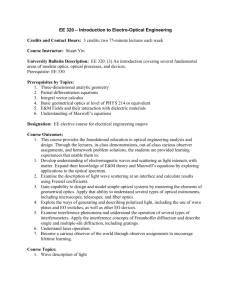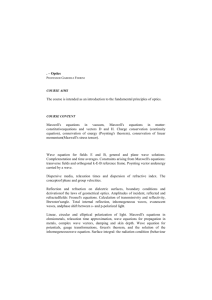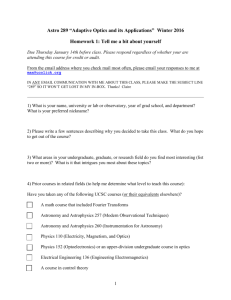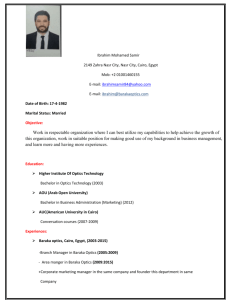1. Modern Optics: Introduction
advertisement
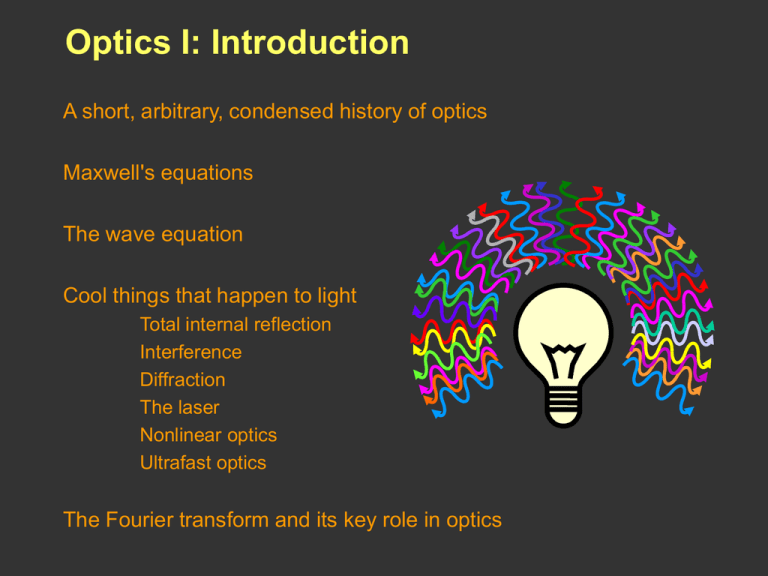
Optics I: Introduction A short, arbitrary, condensed history of optics Maxwell's equations The wave equation Cool things that happen to light Total internal reflection Interference Diffraction The laser Nonlinear optics Ultrafast optics The Fourier transform and its key role in optics Optics in Ancient History A mirror was discovered in workers' quarters near the tomb of Pharaoh Sesostris II (1900 BCE). Pyramid of Sesostris II (also known as Senusret II) Ancient Greeks (500-300 BCE) Burning glass mentioned by Aristophanes (424 BCE) Law of reflection: “Catoptrics” by Euclid (300 BCE) Refraction in water mentioned by Plato in “The Republic” But they thought that the eye emits rays that reflect off objects. Ancient Greeks: Ancient light weapons Early Greek and Roman historians report that Archimedes equipped several hundred people with metal mirrors to focus sunlight onto Roman warships in the battle of Syracuse (213 -211 BCE). This story is probably apocryphal. Optics in the Middle Ages: Alhazen Arab scientist Alhazen (~1000 AD) studied spherical and parabolic mirrors. Alhazen correctly proposed that the eyes passively receive light reflected from objects, rather than emanating light rays themselves. He also explained the laws of reflection and refraction by the slower movement of light through denser substances. Optics in early 17th-century Europe Hans Lippershey applied for a patent on the Galilean telescope in 1608. Galileo (1564-1642) used one to look at our moon, Jupiter and its moons, and the sun. Two of Galileo’s telescopes Galileo’s drawings of the moon Willibrord Snell Willibrord Snell discovered the Law of Refraction, now named after him. q1 n1 q2 Willibrord Snell (1591-1626) n2 ni is the refractive index of each medium. n1 sin(q1 ) n2 sin(q2 ) 17th-century Optics Descartes reasoned that light must be like sound. So he modeled light as pressure variations in a medium (aether). Rene Descartes (1596-1659) Robert Hooke (1635-1703) studied colored interference between thin films and developed the first wave theory of light. Isaac Newton "I procured me a triangular glass prism to try therewith the celebrated phenomena of colours." (Newton, 1665) Isaac Newton (1642-1727) After remaining ambivalent for many years, he eventually concluded that it was evidence for a particle theory of light. James Clerk Maxwell Maxwell unified electricity and magnetism with his now famous equations and showed that light is an electromagnetic wave. E 0 B 0 B E t 1 E B 2 c t James Clerk Maxwell (1831-1879) where E is the electric field, B is the magnetic field, and c is the velocity of light. Maxwell’s equations simplify to the wave equation for the electric field. 2 1 E 2 E 2 0 2 c t which has a simple sine-wave solution: E (r , t ) cos(t k r ) where c / k The same is true for the magnetic field. Light is an electromagnetic wave. The electric (E) and magnetic (B) fields are in phase. The electric field, the magnetic field, and the propagation direction are all perpendicular. Michelson & Morley Michelson and Morley then attempted to measure the earth's velocity with respect to the aether and found it to be zero, effectively disproving the existence of the aether. Albert Michelson Edward Morley (1852-1931) (1838-1923) Albert Einstein Einstein showed that light: is a phenomenon of empty space; has a velocity that’s constant, independent of observer velocity; is both a wave and a particle; Albert Einstein (1879-1955) Excited medium and undergoes stimulated emission, the basis of the laser. The interaction of light and matter Light excites atoms, which then emit more light. Electric field at atom Electron cloud Emitted electric field Incident light + E (t ) xe (t ) E (t ) Emitted light = On resonance (the light frequency is the same as that of the atom) Transmitted light The crucial issue is the relative phase of the incident light and this reemitted light. If these two waves are ~180° out of phase, destructive interference occurs, and the beam will be attenuated—absorption. If they’re ~±90° out of phase: the speed of light changes—refraction. Absorption of light varies massively. Penetration depth into water vs. wavelength 1m Radio Microwave Penetration depth into water 1 km IR UV X-ray Water is clear in the visible, but not in other spectral regions. 1 mm Notice that the penetration depth varies by over ten orders of magnitude! 1 µm 1 km 1m 1 mm 1 µm Wavelength Visible spectrum 1 nm Variation of the refractive index with wavelength (dispersion) causes the beautiful prismatic effects we know and love. Input white beam Dispersed beam Prism Prisms disperse white light into its various colors. Rainbows result from refraction and reflection of sunlight in water droplets. Note that there can be two rainbows, and the top one is inverted. There are many interesting optics effects in real life… An interesting question is what happens to light when it encounters a surface. At an oblique angle, light can be completely transmitted or completely reflected. Total internal reflection is the basis of optical fibers, a billion dollar industry. Light beams can interfere with each other: Two point sources… Different separations. Note the different patterns. Constructive vs. destructive interference… The idea is central to many laser techniques, such as holography, ultrafast photography, and acousto-optic modulators. Tests of quantum mechanics also use it. Light beams can be intentionally made to interfere with each other. Using a partially reflecting mirror, we can split a beam into two. Mirror Beamsplitter Mirror Input beam If we then combine the two beams, their relative phase matters. The above Sagnac Interferometer measures rotation. Often, they do so by themselves. Fourier decomposing functions plays a big role in optics. Here, we write a square wave as a sum of sine waves of different frequency. The Fourier transform is perhaps the most important equation in science. It converts a function of time to one of frequency: E( ) E(t)exp(i t)dt and converting back uses almost the same formula: E(t) 1 2 E( )exp(i t)d The spectrum of a light wave will be given by: E ( ) 2 Diffraction Light bends around corners. This is called diffraction. The light pattern emerging from a single small rectangular opening The diffraction pattern far away is the (2D) Fourier transform of the slit transmission vs. position. Light is not only a wave, but also a particle. Photographs taken in dimmer light look grainier. Very very dim Bright Very dim Very bright Dim Very very bright When we detect very weak light, we find that it’s made up of particles. We call them photons. The Laser A laser is a medium that stores energy, surrounded by two mirrors. Photons entering the medium undergo stimulated emission. As a result, the intensity exiting from the medium exceeds that entering it. A partially reflecting output mirror lets some light out. A laser will lase if the beam increases in intensity during a round trip: that is, if I3 > I0. Electromagnetism is linear: The principle of Superposition holds. If E1(x,y,z,t) and E2(x,y,z,t) are solutions to Maxwell’s equations, then E1(x,y,z,t) + E2(x,y,z,t) is also a solution. This means that light beams pass through each other without affecting each other. Nonlinear Optics produces many exotic effects. Sending high-intensity infrared laser light into a crystal yielded this display of green light: Nonlinear optics allows us to change the color of a light beam, to change its shape in space and time, and to test the fundamental principles of quantum mechanics. Ultrashort laser pulses are the shortest events ever created. This pulse is only 4.5 x 10-15 seconds long, that is, 4.5 femtoseconds: How do we measure such a short event? We must use the event to measure itself.

